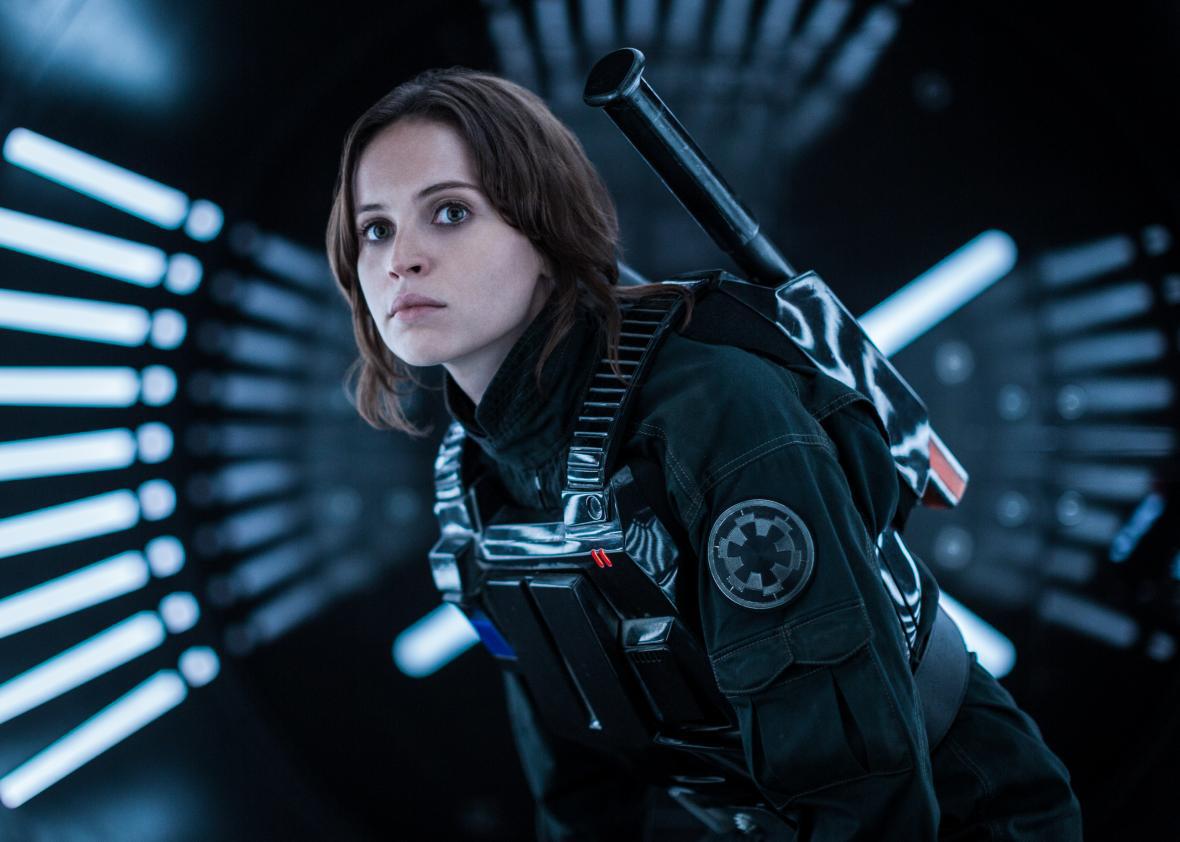There’s a particularly striking moment in Rogue One: A Star Wars Story when Jyn Erso, our spirited protagonist, is trying to persuade the leaders of the rebel forces to attack an Empire stronghold, a seemingly futile task. “We have hope,” Jyn says to the assembled troops, her eyes wide and pleading. “Rebellions are built on hope.” It’s a great scene, with some superb acting from Felicity Jones, but to be honest, I was too distracted to enjoy it. As Jyn is delivering her speech, she’s surrounded by what must be nearly a hundred rebels, and I was busy trying to count how many of them were women. The final tally? Two.
Rogue One is just the second Star Wars movie to put a woman at the center of the action, and I have to admit, I had some trepidation about the character going in. Although Jones is already calling female action heroes “the norm,” female-led Star Wars movies are still very new, and the stewards of the franchise’s legacy are still figuring out how to approach them. Lucasfilm president Kathleen Kennedy, who has been an advocate for meaningful inclusion, has called characters like Jyn or The Force Awakens’ Rey “genuinely female heroes” who are “not necessarily just taking on male characteristics.” But leading up to the movie’s premiere, Rogue One director Gareth Edwards instead touted Jyn as a gender-neutral hero, written as “neither male nor female, as just a person.”
Fortunately, Jyn, like The Force Awakens’ Rey, is a worthy and decidedly female addition to the franchise—and she’s not just Rey 2.0. Though there are similarities between the two characters—physically, for starters, as they’re both played by white brunettes with British accents—Rey’s hardships made her wide-eyed and eager to find the family she never knew, while Jyn’s have turned her worldly and fierce. Disillusioned and rootless after losing her family to the Empire, Jyn hides a warm heart behind a layer of Han Solo–like indifference, and Jones’ eyes tell the story better than the clunky dialogue.
But when it comes to women in Rogue One, Jyn stands nearly alone. Jones may be the first woman to get top billing in a Star Wars movie, but stick around for the movie’s credits and you’ll have to watch 10 other names fly by before you get to the next actress in the lineup, Genevieve O’Reilly, playing Mon Mothma, a Rebel leader who previously made a fleeting appearance in Return of the Jedi, where she was played by Caroline Blakiston. In fact, as Rogue One tells it, Jyn and Mon Mothma are the only two notable women in the entire Rebel Alliance. (A possible third might be Sharon Duncan-Brewster’s Senator Pamlo, but she was there and gone so quickly that I couldn’t even remember her name without looking it up.) Though women may be calling some of the shots, they aren’t shown fighting in the trenches; just as the audience of Jyn’s speech is made up almost entirely of men, there isn’t a single woman in the group of a dozen or so that volunteers for her mission. The two female pilots that do finally arrive later in the battle don’t have five lines between them. They don’t even get names, only call signs: “Blue Three” and “Gold Nine.”
The Force Awakens faced similar criticism about gender inequality when its cast list was first released. But the final film did wind up featuring several other women in significant roles, including Carrie Fisher returning as Leia, Lupita Nyong’o voicing a mentor figure for Rey, and Gwendoline Christie playing a (criminally underused) villain. Not equality, to be sure, but at least The Force Awakens had some additional women hanging around in the background. In Rogue One, even the extras default to male unless specified otherwise. Saw Gerrera’s team of freedom fighters? Men. The Death Star’s engineering team? Men. Merchants? Bridge officers? Random galactic prisoners? You guessed it.
What makes this imbalance especially frustrating is that the Star Wars universe is full of diverse, interesting female characters—they just don’t seem to find their way to the big screen. Instead, they live in in the franchise’s other media, on television and in comics, novelizations, and video games. Rogue One squandered an opportunity to include from Star Wars Rebels’ Hera Syndulla, a Rebel squadron leader, or Sabine Wren, a weapons expert with an affinity for art and explosives. The movie shoehorns in Saw Gerrera, a minor character from Lucasfilm’s late, great animated series, Star Wars: The Clone Wars, as a surrogate parent for Jyn, but it passes over Clone Wars protagonist Ahsoka Tano, apprentice to the man who would become Darth Vader and, later, a key force in establishing the Rebel Alliance. Putting her in this particular live-action Star Wars movie would have been more appropriate, in addition to raising the profile of a beloved but lesser-known female character.
Science fiction is supposed to open up possibilities, not limit them, and it’s important for movies like Star Wars to imagine a galaxy in which women are part of the narrative even when they aren’t the Chosen One. Fortunately, future Star Wars movies already seem to be wisening up, at least a little bit. Episode VIII has added Laura Dern and Kelly Marie Tran to the cast, while the upcoming Han Solo movie is casting a a black actress in a leading role. With any luck, that’s a sign of things to come, and we’ll starting seeing more women, and particularly more women of color, fighting for their causes in Star Wars in the years ahead.
That might be a lot to hope for. But as a smart, lonely heroine once said, rebellions are built on hope.
